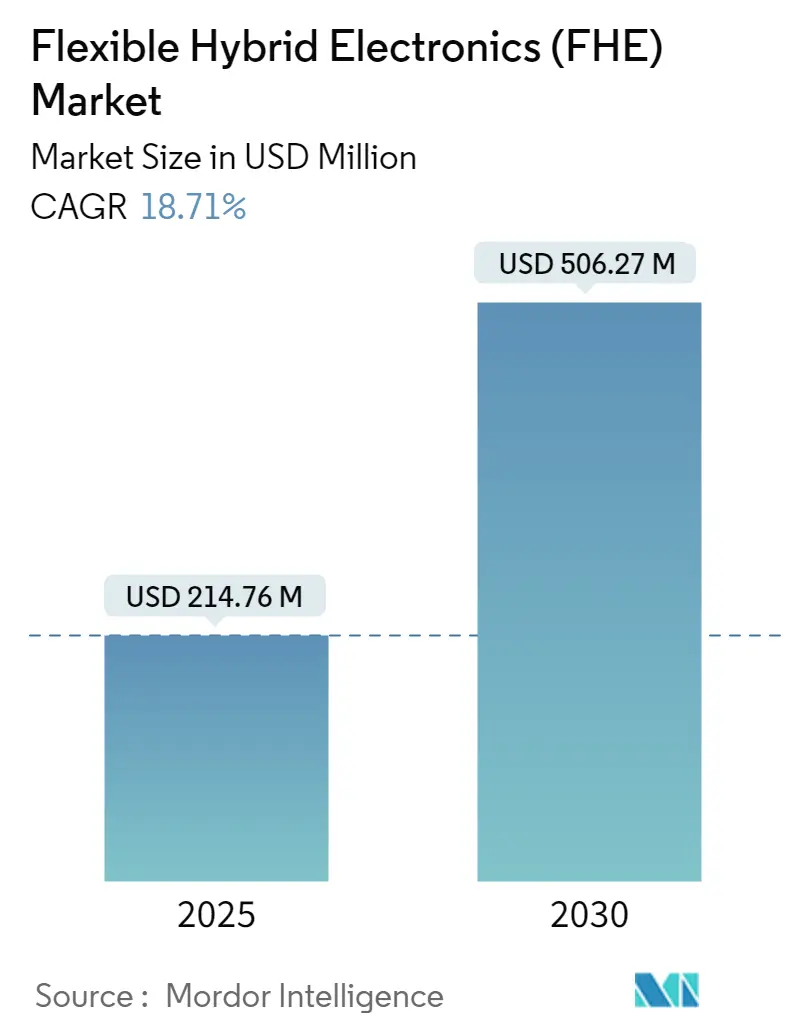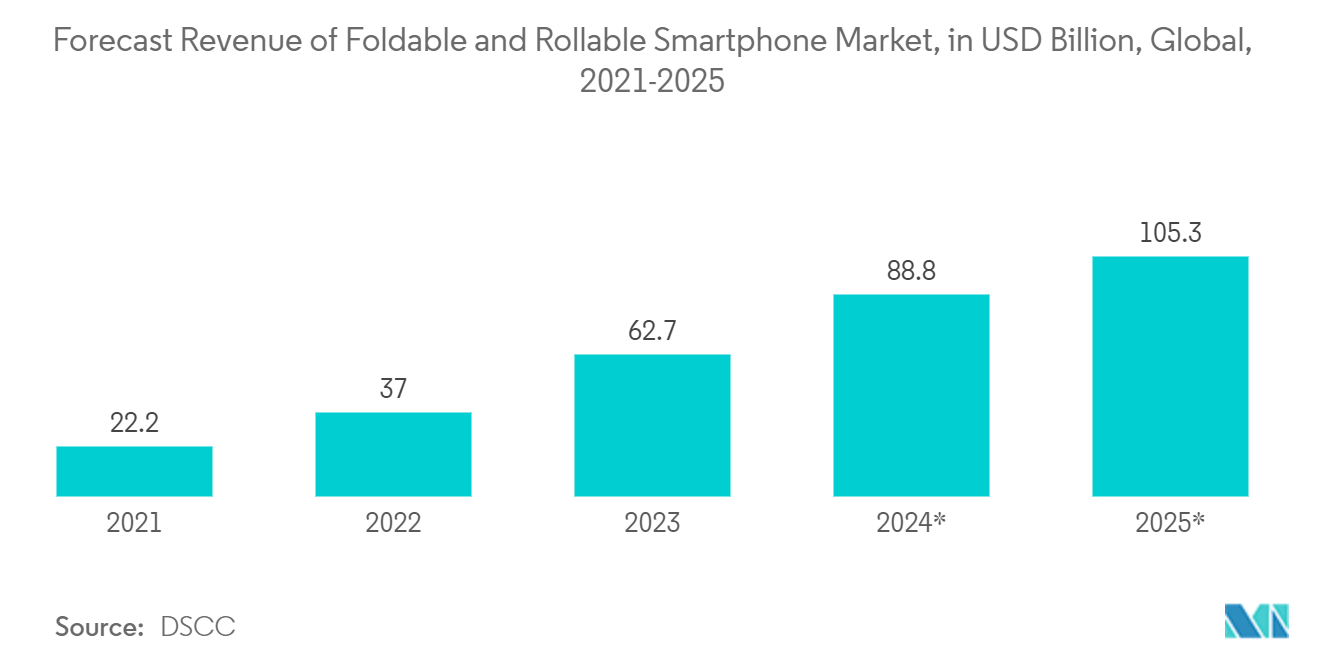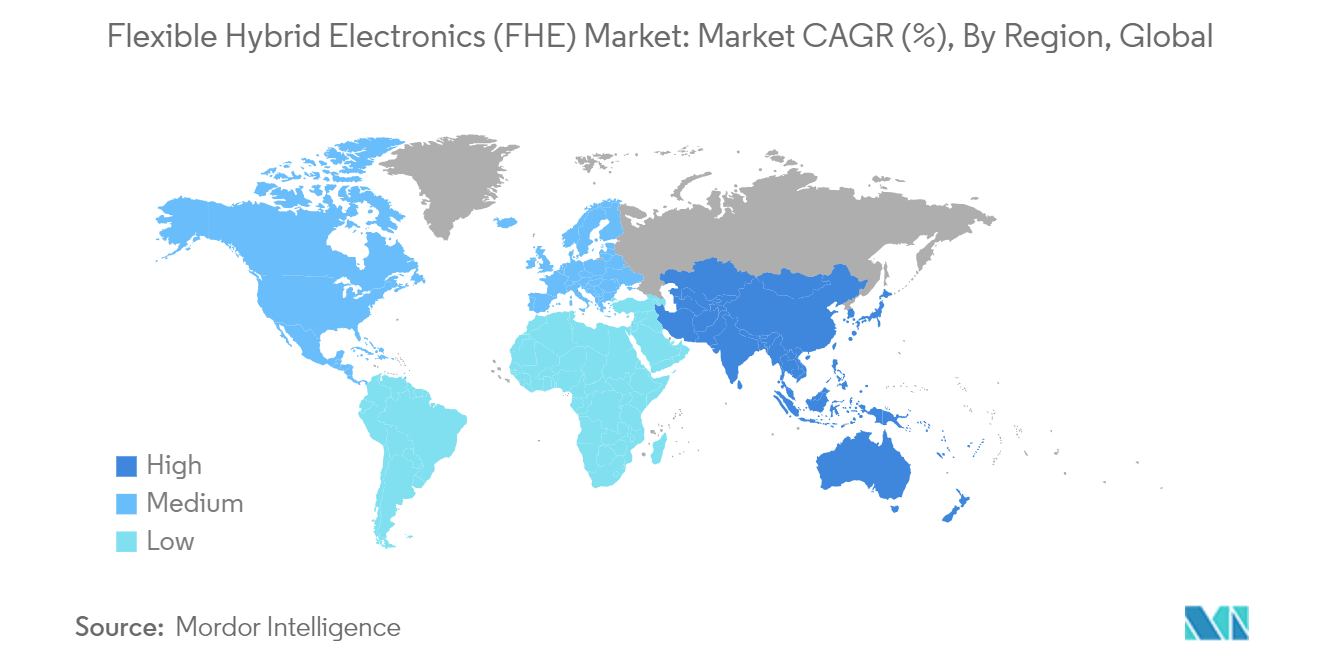Flexible Hybrid Electronics (FHE) Market Analysis
The Flexible Hybrid Electronics Market size is estimated at USD 214.76 million in 2025, and is expected to reach USD 506.27 million by 2030, at a CAGR of 18.71% during the forecast period (2025-2030).
The increasing applications of these electronic components in wearable electronics, performance monitoring systems, structural health monitoring for constructions, soft robotics, and array antennas are expected to drive the market’s growth during the forecast period.
- Hybrid electronics combine the flexibility, lightweight nature, thinness, and large-area electronics with the processing power of semiconductors to open a broad range of new applications across different end-use applications, such as the Internet of Things (IoT), smart buildings, healthcare, product packaging, retail, and consumer electronics.
- Flexible hybrid electronics are also helping product designers use sensors in a new way to collect data and deliver actionable insights that enhance functioning. The growing development and innovations in the market are expected to revolutionize the electronics industry. With the advent of the IoT, flexible hybrid electronics are expected to provide massive opportunities to develop and integrate smart systems and devices for low-cost, everyday use. Industries like automotive, military, aerospace, healthcare, and displays are utilizing flexible and hybrid sensors and wearables in their products.
- Printed electronics is the process of creating electronic circuits and components on various substrates using printing processes such as screen printing, inkjet printing, and gravure printing. To create electrical devices, conductive inks consisting of silver, carbon nanotubes, or conductive polymers are applied to substrates. RFID tags, flexible displays, printed sensors, smart packaging, and e-textiles are a few examples of printed electronics applications. Lightweight, flexible components and scalable and affordable production procedures make them ideal for large-scale applications. Limited electrical performance compared to standard silicon-based devices, inferior durability, dependability, and material qualities hinder performance in demanding situations.
- There is an emerging need for lightweight, mechanically flexible, and cost-effective devices in medical, automotive, and consumer electronics applications. Flexible hybrid electronic devices have gained considerable momentum in catering to the industry’s needs. Flexible electronics have the potential to transform computing by enabling bendable systems with arbitrary shapes.
- Government funding boosts R&D activities, leading to innovations and technological advancements in FHE. This support helps overcome technical challenges, reduces costs, and enhances the performance and reliability of FHE products. The government provided funding for various initiatives, including NextFlex Project Call 4.0, the Semi-Flex Tech Project, and the HiFES (hybrid integrated flexible electronic systems) program.
- The high requirement for research and development (R&D) and infrastructure poses several challenges restraining the demand growth for flexible hybrid electronics (FHE). The significant upfront costs of R&D and infrastructure development deter potential adopters, including businesses and consumers, from investing in FHE technologies. This reluctance stems from concerns over return on investment (ROI) and the affordability of initial deployment.
- There is a greater need for business goods and services during economic expansion. Businesses frequently invest in technology like flexible hybrid electronics that can increase various industries because of this increase in demand for lightweight, flexible, and conformal designs. For instance, according to MOSPI, in the financial year 2023, the contribution of domestic electronics production value to the Indian GDP was about 2.9%. This contribution share was estimated to increase to 4.7% by the financial year 2026. Such possible expansion in electronics production is projected to increase demand in the market studied.
Flexible Hybrid Electronics (FHE) Market Trends
Electronics Application Segment Holds Significant Market Share
- The electronics segment, including sensors, displays, and lighting, in the flexible hybrid electronics (FHE) market scope includes thin fingerprint sensors, printed antennas to test water salinity, and printed LED lighting.
- Flexible hybrid electronics (FHE), a blend of flexible and printed electronics, is gaining momentum for its advantages, including digital additive manufacturing for prototyping, flexibility and stretchability, and compatibility with Roll-to-Roll (R2R) production. FHE merges printed electronics with silicon-based integrated circuits on a flexible substrate. Notable active components from Si CMOS processes include microcontrollers, digital signal processors, high-density memories, and radiofrequency (RF) chips.
- Flexible hybrid electronics is revolutionizing consumer electronics with flexible displays, rollable screens, flexible batteries, and electronic textiles. These advancements lead to more durable and versatile devices. There's a shift in consumer electronics toward ultra-high resolution, paving the way for high-resolution displays, flexible screens, and intricately designed LED lighting. The heightened resolution enhances visual appeal and functionality, enriching the user experience.
- By geography, North America is set for a surge in its electronics sector. In June 2024, the NextFlex consortium, a collaboration between the US Department of Defense (DoD) and FlexTech Alliance, unveiled a new funding opportunity of USD 5.3 million. This initiative aims to accelerate the commercialization of flexible hybrid electronics (FHE) in the United States.
- In May 2024, NextFlex released Project Call 9.0 (PC 9.0), a funding initiative with a total value exceeding USD 11 million. This brings NextFlex's total investment in hybrid electronics advancements to a substantial USD 143 million since its inception. PC 9.0 specifically focuses on enhancing the performance and reliability of hybrid electronic devices.
- The market for flexible and foldable displays is growing significantly, with technologies like micro-LEDs gaining prominence alongside OLEDs. While micro-LED displays offer exceptional quality, their manufacturing is challenging. According to DSCC, the global market for foldable and rollable smartphones witnessed a revenue surge, increasing from USD 4.5 billion in 2020 to USD 5.5 billion. Projections indicate a substantial uptick, with the market poised to exceed USD 105 billion by 2025, reflecting an impressive compound annual growth rate (CAGR) of over 80% from 2020 to 2025.
Asia-Pacific to Register Major Growth
- The Asia-Pacific region, including semiconductor hubs like China, Taiwan, and Japan, hosts many pure-play foundries operated by domestic and international vendors. Chengdu, China, for instance, has a comprehensive industrial cluster, advanced technology for new material production, a vast consumer market, and a strong R&D foundation, especially for high-performance materials.
- The region also holds a significant share of global demand for connected wearables and is one of the fastest-growing markets. Countries like China, Japan, and Singapore are seeing increased demand for flexible smartphones and consumer electronics. The Japanese electronics market is focusing on miniaturizing products with flexible hybrid electronics.
- Consequently, companies like Samsung, LG, and Apple are launching flexible smartphones exclusively in the region. Chinese vendors are innovating by collaborating with universities and research institutes. For example, Tsinghua University researchers developed ultra-thin flexible chips, less than 25 micrometers thick, that can be embedded in various materials on flexible substrates.
- In December 2023, Chengdu Hi-tech Industrial Development Zone (CDHT) hosted the China Flexible Electronics Industry Development Conference and the 4th ‘Golden Panda’ Global Flexible Electronic Industry Innovation and Entrepreneurship Competition. The event aimed to bolster industrial ecosystems and propel Chengdu's FHE sector. CDHT leverages industrial investment funds to integrate capital and industry chains. By 2027, CDHT plans to roll out RMB 300 billion (USD 413.7 billion) in industrial funds, attracting diverse industry collaborators. Flexible hybrid electronics are crucial for China's self-reliance and technological strength. CDHT aims to establish an exchange platform to consolidate technologies and projects in the FHE industry chain.
- The Chinese FHE industry gained global prominence, as noted by the Flexible Electronic Industry Development Alliance. To capitalize on this, China must plan its industrial layout, establish the "China Carbon Valley" base, focus on core technology research, enhance top-level design, and leverage its flexible hybrid electronics talent.
Flexible Hybrid Electronics (FHE) Industry Overview
The flexible hybrid electronics market is highly fragmented with the presence of major players like DuPont Teijin Films, Domicro BV, General Electric Company, Lockheed Martin Corporation, and American Semiconductor Inc. Players in the market are adopting strategies such as partnerships and acquisitions to enhance their product offerings and gain sustainable competitive advantage.
- April 2024: Brewer Science Inc. launched its innovative smart warehouse monitor system, a game-changer in workplace safety and productivity. This advanced solution engineered for industrial and warehouse applications provides real-time data, ensuring employee safety, enhancing productivity, and optimizing operational efficiency.
- February 2024: DuPont Teijin Films globally rebranded to Mylar Specialty Films. This rebranding is expected to affect all international operations and offices in the United States, Europe, and Asia. The decision to adopt the new company name pays homage to the legacy of the Mylar brand, which was first introduced as the pioneering biaxially oriented PET film in the 1950s.
Flexible Hybrid Electronics (FHE) Market Leaders
-
DuPont Teijin Films
-
Domicro BV
-
General Electric Company
-
Lockheed Martin Corporation
-
American Semiconductor Inc
- *Disclaimer: Major Players sorted in no particular order
Flexible Hybrid Electronics (FHE) Market News
- April 2024: Epicore Biosystems announced the commercial launch of Connected Hydration. This innovative product includes a wearable patch and a mobile app designed to monitor sweat volume, electrolyte levels, body temperature, and movement. Providing personalized, real-time data enables workers to proactively manage their hydration needs, preventing adverse dehydration events.
- January 2024: ARA's strategic initiatives yielded significant recognition from prominent organizations. ARA received the AFRL Award for advancing resistive film production, with contributions from Logen Thiran. In addition, the company secured a USD 26.7 million Congressional Interest Item Strategic Funding Increase award, along with financial support from the state of Missouri. ARA collaborated with Missouri State University's Jordan Valley Innovation Center to advance this initiative.
Flexible Hybrid Electronics (FHE) Industry Segmentation
Flexible hybrid electronics are the devices that combine the flexibility and low cost of printed plastic film substrates with the performance of semiconductor devices to create a new category of electronics. FHE is the convergence of additive circuitry, passive devices, and sensor systems typically manufactured using printing methods and thin, flexible silicon chips. The market is defined by the revenue generated through flexible hybrid electronics (FHE) solutions offered by various market players operating in the market.
The flexible hybrid electronics (FHE) market is segmented by application (electronics, health performance tools, security tag, and industrial and environmental monitoring) and by geography (North America, Europe, Asia Pacific, and the rest of the World). The report offers market forecasts and size in value (USD) for all the above segments.
| By Application | Electronics | ||
| Health Performance Tool | Application Summary and Market Potential | ||
| Use-cases | |||
| Security Tag | |||
| Industrial and Environmental Monitoring | |||
| By Geography*** | North America | ||
| Europe | |||
| Asia | |||
| Australia and New Zealand | |||
| Latin America | |||
| Middle East and Africa | |||
Flexible Hybrid Electronics (FHE) Market Research FAQs
How big is the Flexible Hybrid Electronics Market?
The Flexible Hybrid Electronics Market size is expected to reach USD 214.76 million in 2025 and grow at a CAGR of 18.71% to reach USD 506.27 million by 2030.
What is the current Flexible Hybrid Electronics Market size?
In 2025, the Flexible Hybrid Electronics Market size is expected to reach USD 214.76 million.
Who are the key players in Flexible Hybrid Electronics Market?
DuPont Teijin Films, Domicro BV, General Electric Company, Lockheed Martin Corporation and American Semiconductor Inc are the major companies operating in the Flexible Hybrid Electronics Market.
Which is the fastest growing region in Flexible Hybrid Electronics Market?
Asia Pacific is estimated to grow at the highest CAGR over the forecast period (2025-2030).
Which region has the biggest share in Flexible Hybrid Electronics Market?
In 2025, the North America accounts for the largest market share in Flexible Hybrid Electronics Market.
What years does this Flexible Hybrid Electronics Market cover, and what was the market size in 2024?
In 2024, the Flexible Hybrid Electronics Market size was estimated at USD 174.58 million. The report covers the Flexible Hybrid Electronics Market historical market size for years: 2019, 2020, 2021, 2022, 2023 and 2024. The report also forecasts the Flexible Hybrid Electronics Market size for years: 2025, 2026, 2027, 2028, 2029 and 2030.
Our Best Selling Reports
Flexible Hybrid Electronics (FHE) Industry Report
Statistics for the 2025 Flexible Hybrid Electronics (FHE) market share, size and revenue growth rate, created by Mordor Intelligence™ Industry Reports. Flexible Hybrid Electronics (FHE) analysis includes a market forecast outlook for 2025 to 2030 and historical overview. Get a sample of this industry analysis as a free report PDF download.







